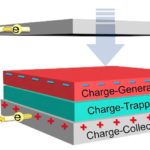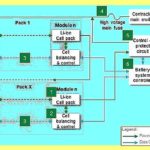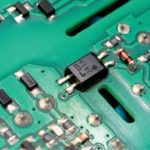Lithium-ion battery (LIB) safety is a major concern for designers. LIBs are generally safe to use if they have been properly manufactured and are integrated correctly into systems. However, the use of sub-standard materials and the possibility of manufacturing or design defects can result in hazardous conditions. As a result, there are many global safety standards related to LIBs. This FAQ first looks at the potential for, and consequences of, thermal runaway in LIBs, it looks at the most-commonly-cited LIB safety standards, it reviews the non-standard nature of so-called “nail penetration” testing, looks at the hazard levels associated with LIBs in electric vehicles and closes with a brief look at coin cell safety standards.
Thermal runaway (TR) in LIBs can be a catastrophic event. It can have several causes, such as dendrite formation, manufacturing defects, physical damage during use, and so on. It doesn’t happen all at once but in a series of stages. The first stage is the beginning of overheating (Figure 1). If it is not extinguished, the solid electrolyte interface (SEI) decomposes, and heat continues to build up, resulting in more side reactions, possibly melting the separator. As the heating continues and the pace of temperature rise increases, the TR phase is entered. TR is defined as a self-heating rate of at least 10°C /min. As it accelerates, TR leads to uncontrollable temperatures, and the cell may burst or even explode. Temperatures of 200 °C or even higher will be experienced, and the cell will catch on fire.

Small Li-battery standards
The three most-commonly cited LIB safety standards are:
- UN/DOT 38.3 5th Edition, Amendment 1 – Recommendations on the Transport of Dangerous Goods
- IEC 62133-2:2017 – Safety requirements for portable sealed secondary lithium cells, and batteries made from them, for use in portable applications – Part 2: Lithium systems
- UL 2054 2nd Edition – Household and Commercial Batteries
LIBs that do not satisfy UN/DOT 38.3 are limited to being shipped via ground transport as Class 9 Hazardous Goods. While it is possible to self-certify to this standard, most companies use third-party testing labs to limit liability. UN 38.3 includes a combination of environmental, mechanical, and electrical stresses, in sequence (T1-T5):
T1 – Altitude Simulation (primary and secondary cells and batteries)
T2 – Thermal Test (primary and secondary cells and batteries)
T3 – Vibration (primary and secondary cells and batteries)
T4 – Shock (primary and secondary cells and batteries)
T5 – External Short Circuit (primary and secondary cells and batteries)
T6 – Impact (primary and secondary cells)
T7 – Overcharge (secondary batteries)
T8 – Forced Discharge (primary and secondary cells)
The vibration test (T3) is the most challenging since it includes survival of intense vibration for three hours in each of the three cardinal planes. The sequence from T1 to T5 typically has a negative cumulative impact, making it more challenging to pass T6, T7, and/or T8, depending on the requirements.
UN/DOT 38.3 is an integral requirement of IEC 62133-2:2017. IEC 62133-2 adds four additional tests:
- Molded Case Stress
- External Short Circuit
- Free Fall
- Overcharging of Battery
These tests are not nearly as challenging as the tests required to meet UN/DOT 38.3.
The situation with UL 2054 is unclear going forward. A number still requires UL 2054 compliance of U.S. end device standards. The first edition of UL 62133 has been released and is fully harmonized with IEC 62133, and the requirements of UL 2054 and UL 62113 are quite different. For example, IEC 62133 is primarily concerned with fire or explosion hazards with the battery, while UL 2054 is looking at exposure concerns. As a result, the IEC test specifies the use of fully charged batteries, and the UL test specifies the use of fully discharged batteries. UL 2054 is the more complex of these standards and includes about twice the number of tests compared with UN/DOT 38.3 or IEC/UL 62113:
- 7 electrical tests
- 4 battery enclosure tests
- 4 mechanical tests
- 1 fire exposure test
- 2 environmental tests
Cylindrical, pouch, prismatic, or coin?
The four most commonly LIB cell formats are cylindrical, prismatic, coin, and pouch cells. Cylindrical cells are available in high- and low-capacity formats. Low-capacity cells have lower impedances and are used in more applications (for a discussion of the various cylindrical LIBs, see “18650, 21700, 30700, 4680 and other Li-ions – what’s the difference?”). Prismatic cells typically have larger capacities and can simplify system design, but they are also more expensive than cylindrical cells. Pouch cells are gaining in popularity since they offer packaging flexibility to match the cell to a specific device shape. Coin cells are inherently low-capacity devices and are used in small portable devices.
Internal short-circuiting is the most critical abuse test applied to most LIBs. In real-world applications, internal short-circuiting can arise from various causes, such as mechanical damage or production flaws. The most spectacular form of internal short circuit testing can be the “nail penetration” test. Nail penetration testing is typically reserved for scientific investigations into thermal runaway and internal short-circuiting of LIBs. It is not a standardized test and is subject to several variables, including the type and size of nail used, the rate at which the nail penetrates the cell, the state of charge of the cell, and so on (Figure 2).

Considering safety, larger cell sizes are more challenging. The physical construction also has a major impact on safety, with cylindrical cells the safest, prismatic cells the least safe, and pouch cells somewhere in the middle. In part, that is related to keeping the cells cool; the heat dissipation of prismatic cells is the worst, while the gaps between cylindrical calls in battery packs tend to simplify thermal management. Cylindrical and prismatic cells have metallic casings that can withstand high pressures. That can be a negative if there is an internal short circuit since pressures can build up to potentially explosive levels. Pouch cells tend to burst under lower pressures and can catch fire but rarely experience explosions. Selection of the ‘best’ cell format is a complex process, and each of the three packaging formats is used by different EV makers. Adding to the complexity, there are various regional and global EV battery safety standards with differing requirements (Table 1).

Hazard levels
In EVs, hundreds to thousands of cells are combined in the battery pack, increasing the challenges for battery safety. Under normal operating conditions, EV battery thermal management is difficult. When abnormal conditions occur, such as an accident, the challenges can become unmanageable. That’s where the concept of “hazard levels” is applied. The EUCAR and SAE-J Hazard Levels and the associated criteria are widely applied to determine the safety of EV battery packs (Table 2).

Button cell safety
On the other end of the size spectrum, button cells, also called coin cells, LIBs are attracting attention due to their potential to cause serious injury or death to children. For example, UL 4200A received ANSI approval in June 2021. It applies only to household-type products requiring these batteries that are used in areas where children are normally present. UL 4200A is designed to help reduce the risk of children removing button and coin cell batteries from a product and ingesting the batteries.
Devices that include a removable button cell LIB are limited by UL 4200A to specific methods to prevent the battery from being removed by a child. The standard also includes marking the devices, including warnings to keep the batteries away from children. It also includes specific language describing the potential harm from a child swallowing a LIB and the need for immediate medical attention.
There are also a growing number of country-specific and regional safety standards for button cell LIBs. For example, PAS 7055:2021 from the British Standards Institute was released in April 2021. It specifies safety requirements for non-lithium button and lithium coin batteries up to 32 mm in diameter and the products that use them.
Summary
There are a wide variety of safety standards for LIBs. A perfectly designed LIB in a well-designed system that is properly used poses very low safety hazards. The standards recognize that perfection is not within reach even with the most advanced manufacturing and system integration technologies. The standards are designed to maximize safety under real-world conditions that are often imperfect. Since these various standards are under constant review and are evolving, designers need to keep up with the latest developments.
References
A review of lithium-ion battery safety concerns: The issues, strategies, and testing standards, Journal of Energy Chemistry
Button and coin batteries safety requirements specification, British Standards Institute
Development of a New Procedure for Nail Penetration of Lithium-Ion Cells to Obtain Meaningful and Reproducible Results, Journal of the Electrochemical Society
IEC 62133-2:2017, International Electrotechnical Commission
Products Incorporating Button or Coin Cell Batteries of Lithium Technologies, UL 4200A, Underwriters Laboratories
Safety Issues in Lithium Ion Batteries: Materials and Cell Design, Frontiers in Energy Research
Tracking Internal Temperature and Structural Dynamics during Nail Penetration of Lithium-Ion Cells, Journal of the Electrochemical Society
UN DOT 38.3 Testing, TÜV SÜD







Leave a Reply